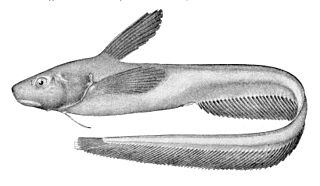
A tuna is a saltwater fish that belongs to the tribe Thunnini, a subgrouping of the Scombridae (mackerel) family. The Thunnini comprise 15 species across five genera, the sizes of which vary greatly, ranging from the bullet tuna up to the Atlantic bluefin tuna, which averages 2 m (6.6 ft) and is believed to live up to 50 years.

Mackerel is a common name applied to a number of different species of pelagic fish, mostly from the family Scombridae. They are found in both temperate and tropical seas, mostly living along the coast or offshore in the oceanic environment.

Manta rays are large rays belonging to the genus Mobula. The larger species, M. birostris, reaches 7 m (23 ft) in width, while the smaller, M. alfredi, reaches 5.5 m (18 ft). Both have triangular pectoral fins, horn-shaped cephalic fins and large, forward-facing mouths. They are classified among the Myliobatiformes and are placed in the family Myliobatidae. They have the largest brains and brain to body ratio of all fish, and can pass the mirror test.

The jellynose fishes or tadpole fishes are the small order Ateleopodiformes. This group of ray-finned fish is monotypic, containing a single family Ateleopodidae. It has about a dozen species in four genera, but these enigmatic fishes are in need of taxonomic revision.

The mosaic gulper shark is a small rare deepwater dogfish, found in the Pacific Ocean around Honshū, Japan and the Hawaiian Islands at depths between 260 and 728 m. It is one of 13 described species in the genus Centrophorus.

The climbing perch is a species of amphibious freshwater fish in the family Anabantidae. A labyrinth fish native to Far Eastern Asia, the fish inhabits freshwater systems from Pakistan, India, Bangladesh and Sri Lanka in the west, to Southern China in the east, and to Southeast Asia west of the Wallace Line in the south. It is likely that Anabas testudineus is a species complex, with the binomial name applied to what are actually several different species. With further study, populations of this fish may be divided up into separate species and given new names. In Nepalese Terai it is called "Pothiya".

The whitecheek shark or widemouth blackspot shark is a requiem shark of the family Carcharhinidae, found in the Indo-West Pacific Ocean between latitudes 34°N and 25°S. It can reach a length of 1 m. It feeds mainly on fish, cephalopods, and crustaceans. It is a viviparous species, with the female giving birth to up to four live young.
Hynobius katoi is a species of salamander in the family Hynobiidae, endemic to Japan. Its natural habitats are temperate forests and rivers.
Ateleopus is a genus of ray-finned fish in the jellynose family Ateleopodidae. It is the type genus of its family, and the order Ateleopodiformes. For some time, it was known as Podateles, because Ateleopus had been used to replace the frog genus name Atelopus, which was deemed to be a spelling error. This was mistaken, however, and the fish and frog genera reverted to their original names.

Eels are ray-finned fish belonging to the order Anguilliformes, which consists of eight suborders, 20 families, 164 genera, and about 1000 species. Eels undergo considerable development from the early larval stage to the eventual adult stage and are usually predators.

Whale conservation refers to the conservation of whales.

Guentherus is a genus of jellynose fishes, belonging to the Ateleopodidae family, with two recognized species:
Archiminolia katoi is a species of sea snail, a marine gastropod mollusk in the family Solariellidae.

Cirrhilabrus katoi is a species of wrasse native to Japan. It is found in groups at depths from 20 to 40 m.
The pacific jellynose fish is a species of jellynose fish in the family Ateleopodidae. It can grow up to a length of 95 cm, but is more commonly found at lengths of 35 cm. There are three other species in its genus. It feeds on prawns, and is harmless to humans. It is benthic, and lives at depths from 140 to 600 meters, but it may rise up to 100 meters at night, in areas like China, Japan, Malaysia, New Caledonia, Taiwan, and Vietnam in the Indo-Pacific. It is a rare fish to encounter, and its population seems to be stable, but it may be a bycatch in fisheries.

Ijimaia plicatellus is a species of jellynose fish in the family Ateleopodidae. Their distribution is in the Eastern Central Pacific near Hawaii, at depths from 265 to 500 meters. The species can reach up to 68 centimeters in length.
Parapercis katoi is a fish species in the sandperch family, Pinguipedidae. It is found in Japan. This species reaches a length of 17.7 cm (7.0 in).
Ijimaia dofleini, often called the Ô-shachiburi in Japanese, is a species of ray-finned fish within the family Ateleopodidae. The species is known from four localities in the Pacific Ocean. These localities were in marine waters of the Sagami Sea, Ryuku Islands, Taiwan, and Society Islands at depths of 300 to 500 meters, living near benthopelagic environments on outer continental shelfs and slopes. The species can grow up to lengths of 124 to 170 centimeters. It has been assessed as 'Data deficient' by the IUCN Red List in 2018 due to there being limited information on its distribution, population, and ecology.
Ijimaia antillarum is a species of ray-finned fish within the family Ateleopodidae. The species has a range off of parts of North and South America in the Atlantic, spanning from New England states to Suriname and Santa Catarina to Tramandai in Brazil off continental slopes, inhabiting benthopelagic environments 320 to 732 meters below sea level. Lengths of the species range from 85.5 to 165 centimeters. The species has been assessed as 'Least concern' in 2019 by the IUCN Red List due to its large range and lack of any known major threats.












